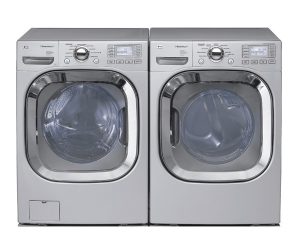Clothes washing machines are household appliances designed to clean clothes and fabrics through a combination of water, detergent, and mechanical action.
Here’s a general explanation of how washing machines work:
How washing machine work 
- Loading: You load the dirty clothes into the washing machine’s drum, either from the top (top-loading machines) or the front (front-loading machines).
- Water inlet: The washing machine is connected to a water supply. When you start a wash cycle, water enters the machine through an inlet valve, which is controlled by the machine’s electronic or mechanical controls.
- Detergent dispenser: Washing machines typically have a detergent dispenser drawer or compartment. You add the appropriate amount of laundry detergent, fabric softener, or other additives to the dispenser, following the manufacturer’s instructions.
- Mixing and agitating: Once the water fills the drum, the washing machine begins to agitate the clothes. Agitation is the process of moving the clothes around in the water to ensure proper cleaning. The agitator or impeller in the center of the drum creates a back-and-forth or rotating motion, depending on the machine type, to mix the clothes with the water and detergent.
- Water temperature and cycle selection: Depending on the settings you choose, the washing machine can control the temperature of the water. You can select between hot, warm, or cold water, depending on the fabric type and the level of cleaning required. Some machines also offer specialized cycles, such as delicate, heavy-duty, or quick wash, to accommodate different types of fabrics and soil levels.
- Rinse cycle: After the clothes have been agitated and cleaned in the detergent solution, the washing machine enters the rinse cycle. During this phase, fresh water is introduced into the drum to remove the detergent and any remaining dirt or residue from the clothes. The machine may go through multiple rinse cycles to ensure thorough rinsing.
- Spin cycle: Once the rinse cycle is complete, the washing machine enters the spin cycle. During this phase, the drum rotates at a high speed to remove excess water from the clothes. The centrifugal force generated by the spinning motion pushes the water out of the clothes and towards the drum’s walls. The water is then drained out of the machine.
- Drainage: Washing machines have a drain pump or mechanism to remove the dirty water from the drum. The water is expelled through a drain hose, usually connected to a plumbing drain or sink. Some machines also have a lint filter or trap to capture lint and debris during the draining process.
- Optional features: Modern washing machines often come with additional features and technologies. These may include options for pre-soaking, delayed start, steam cleaning, eco-friendly modes, and smart connectivity for remote control and monitoring.
It’s important to note that the specific operation and features of washing machines can vary depending on the model and manufacturer.
Always refer to the user manual provided with your washing machine for detailed instructions on how to operate and maintain it properly.
Types of washing machines 
There are several different types of clothes washing machines available on the market. The main types are:
- Top-Loading Washing Machines: Top-loading machines are the most common type of washing machines. They have a vertical drum that is accessed from the top. These machines are generally more affordable and have a faster washing cycle compared to front-loading machines. They are also convenient for adding or removing laundry during the wash cycle. However, they tend to use more water and energy compared to front-loading machines.
- Front-Loading Washing Machines: Front-loading machines have a horizontal drum that is accessed from the front. These machines are known for their efficiency and performance. Front-loaders typically use less water and energy, provide better cleaning results, and are gentler on clothes. They often have larger capacities and offer additional features like steam cleaning. However, they are generally more expensive upfront and require bending down to load and unload laundry.
- High-Efficiency (HE) Washing Machines: High-efficiency machines can be either top-loading or front-loading. They are designed to use less water and energy compared to traditional models. HE machines typically have advanced features such as sensors to optimize water usage based on the load size and soil level. They often require the use of specially-formulated HE laundry detergents for best results.
- Compact Washing Machines: Compact washing machines are smaller-sized units designed for apartments, small spaces, or individuals with minimal laundry needs. They can be either top-loading or front-loading and have a reduced capacity compared to standard-sized machines. Compact washers are often stackable and offer flexibility for installation in tight spaces.
- Washer-Dryer Combo: Washer-dryer combo units, as mentioned earlier, combine the functionality of a washing machine and a dryer in a single appliance. These units are convenient for small spaces or situations where separate washer and dryer units are not feasible. However, their drying capacity is typically smaller compared to standalone dryers.
- Portable Washing Machines: Portable washing machines are compact, lightweight, and designed for mobility. They are suitable for RVs, camping trip
 s, or situations where access to a traditional washing machine is limited. Portable washers usually have smaller capacities and operate with a manual filling and draining process.
s, or situations where access to a traditional washing machine is limited. Portable washers usually have smaller capacities and operate with a manual filling and draining process.
It’s important to consider factors such as available space, laundry needs, energy efficiency, budget, and personal preferences when choosing a washing machin
e.
Each type has its own advantages and considerations, so it’s helpful to evaluate your specific requirements before making a decision.
Click Here for access to the blog page for more helpful hints and advise, for all home appliances.
Click Here to book an appointment to get all your home appliances repaired, serviced or new appliances installed.







